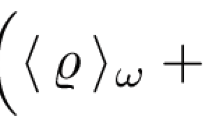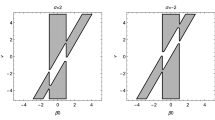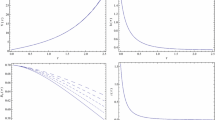Abstract
The algebraic classification of stress-energy tensors includes tensors whose symmetry is partly broken as compared with Einstein’s maximally symmetric cosmological term. This allows us to introduce, in a general setting, a vacuum dark fluid with variable density and pressures approaching the cosmological constant in certain space-time regions. The relevant class of Einstein equations describes cosmological models with time-evolving and spatially inhomogeneous vacuum dark energy and compact objects with de Sitter interiors generically related to vacuum dark energy, which can be responsible for observational effects typical of dark matter. The mass of objects is generically related to breaking of space-time symmetry from the de Sitter group. We outline the basic generic properties of regular cosmological models with vacuum dark energy, and of dark matter candidates with de Sitter interiors, including their observational signatures.
Similar content being viewed by others
References
A. G. Riess et al., Astron. J. 116, 1009 (1998)
A. G. Riess et al., Astron. J. 117, 707 (1999)
S. J. Perlmutter et al., Astrophys. J 517, 565 (1999)
N. A. Bahcall et al., Science 284, 1481 (1999).
L. Anderson et al., Mon. Not. R. Astron. Soc. 441, 24 (2014).
E. B. Gliner and I. G. Dymnikova, Sov. Astron. Lett. 1, 93 (1975).
D. A. Tretyakova, Grav. Cosmol. 22, 339 (2016).
P. S. Corasaniti et al., Phys. Rev. D 70, 083006 (2004).
E. J. Copeland, M. Sami, and S. Tsujikawa, Int. J. Mod. Phys. D 15, 1753 (2006).
I. Dymnikova, Grav. Cosmol. 5 Suppl, 15 (1999)
I. Dymnikova, Phys. Lett. B 472, 33 (2000).
K. A. Bronnikov, A. Dobosz and I. Dymnikova, Class. Quant. Grav. 20, 3797 (2003).
K. Bronnikov, I. Dymnikova and E. Galaktionov, Class. Quant. Grav. 29, 095025 (2012).
L. Marochnik, Grav. Cosmol. 23, 201 (2017).
K. Bamba, S. Capozziello, S. Nojiri, and S. D. Odintsov, Astrophys. Space Sci. 342, 155 (2012)
A. B. Rivera and J. G. Farieta, arXiv:1605.01984 (2016)
A. Joyce, L. Lombriser, and F. Schmidt, Ann. Rev. Nucl. Part. Sci. 66, 95 (2016).
V. Sahni, A. Shafiello, and A. A. Starobinsky, Astrophys. J. 793, L40 (2014).
I. Dymnikova and E. Galaktionov, Phys. Lett. B 645, 358 (2007).
I. Dymnikova, A. Dobosz, M. Filchenkov, and A. Gromov, Phys. Lett. B 506, 351 (2001).
K. A. Bronnikov and I. Dymnikova, Class. Quantum Grav. 24, 5803 (2007).
I. Dymnikova, Int. J. Mod. Phys. D 21, 1242007 (2012).
I. Dymnikova, A. Dobosz, and B. Sołtysek, Gravi. Cosmol. 23, 28 (2017).
I. Dymnikova and M. Korpusik, Phys. Lett. B 685, 12 (2010)
I. Dymnikova and M. Korpusik, Entropy 13, 1967 (2011).
I. Dymnikova, Int. J. Mod. Phys. D 5, 529 (1996).
I. Dymnikova, Class. Quantum Grav. 19, 725 (2002).
I. Dymnikova, in: Invisible universe, AIPConf.Proc. 1241, 361 (2010).
I. Dymnikova and E. Galaktionov, Cent. Eur. J. Phys. 9, 644 (2011).
I. Dymnikova, E. Galaktionov, and A. Poszwa, Grav. Cosmol. 17, 38 (2011).
I. Dymnikova and M. Fil’chenkov, Adv. High Energy Phys. 2013, 746894 (2013).
I. Dymnikova and M. Khlopov, Int. J. Mod. Phys. D 24, 1545002 (2015).
I. Dymnikova, Universe 3, 20 (2017).
L. D. Landau and E.M. Lifshitz, Classical theory of fields (Pergamon Press, 1975).
G. W. Gibbons, DAMTP-2003-19 (Cambridge University); hep-th/0302199 (2003).
I. Dymnikova, Gen. Rel. Grav. 24, 235 (1992).
I. Dymnikova, Int. J. Mod. Phys. D 12, 1015 (2003).
I. Dymnikova and B. Soltysek, Gen. Rel. Grav. 30, 1775 (1997).
G.W. Gibbons and S. W. Hawking, Phys. Rev. D 15, 2738 (1977).
T. Padmanabhan, Class. Quantum Grav. 19, 5387 (2002).
G.’t Hooft, “Dimensional reduction in quantum gravity,” gr-qc/9310026.
L. Susskind, J. Math. Phys. 36, 6377 (1995)
R. Bousso, Class. Quantum Grav. 17, 997 (2000).
A. G. Polnarev and M. Yu. Khlopov, Sov. Phys. Uspekhi 28, 213 (1985).
J. H. McGibbon, Nature 329, 308 (1987).
E. J. Copeland et al., Phys. Rev. D 49, 6410 (1994).
B. J. Carr et al., Phys. Rev. D 50, 4853 (1994).
L. Susskind, J. Math. Phys. 36, 6377 (1995).
G. F. R. Ellis, arXiv: 1310.4771.
Y. S. Myung, Y. W. Kim, and Y. J. Park, Phys. Lett. B 645, 393 (2007).
D. Boyanovsky et al., Ann. Rev. of Nuclear and Particle Science 56, 441 (2006).
O. E. Kalashev, G. I. Rubtsov, and S. V. Troitsky, Phys. Rev. D 80, 103006 (2009).
Author information
Authors and Affiliations
Corresponding author
Rights and permissions
About this article
Cite this article
Dymnikova, I. DE-DM Unification Based on Space-Time Symmetry. Gravit. Cosmol. 24, 178–185 (2018). https://doi.org/10.1134/S020228931802007X
Received:
Published:
Issue Date:
DOI: https://doi.org/10.1134/S020228931802007X




